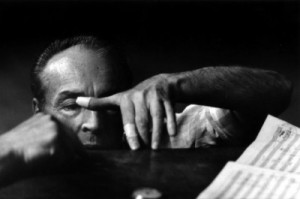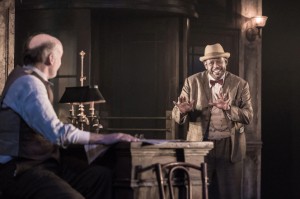 After living out of suitcases for the past two months, Mrs. T and I said farewell to Florida, returned at long last to our Manhattan apartment on Saturday night, and fell into bed with abject gratitude.
After living out of suitcases for the past two months, Mrs. T and I said farewell to Florida, returned at long last to our Manhattan apartment on Saturday night, and fell into bed with abject gratitude.
It isn’t that we regretted so much as an hour of our time on the road. (O.K., we both regretted each and every second of the time we spent sitting in airports, but that’s not what I’m talking about.) Not only do we both love the Sunshine State, but we saw and heard many wonderful things there, including a stirring rehearsal of Rossini’s Stabat Mater by the Bach Festival Society of Winter Park, which will be premiering my latest collaboration with Paul Moravec, a choral ode to music, in April. We also went to several exceptionally fine shows, foremost among them a letter-perfect revival of Eugene O’Neill’s Long Day’s Journey Into Night at Palm Beach Dramaworks, where I’ll be directing Satchmo at the Waldorf in May (that’s why I didn’t review it in The Wall Street Journal).
In addition, I flew up to Chicago and San Francisco in January to open new productions of Satchmo, both of which were successful far beyond my wildest expectations, and I wrote the first draft of a brand-new play, about which—perhaps—much more in due course.
To be sure, we didn’t spend the whole of our time in Florida immersed in the world of art. The sun shone on us with fair frequency, and while it wasn’t as warm as we would have liked, it was usually pleasant enough for us to look at, walk by, and (on occasion) swim in the sea. That beats twenty-below-zero weather all hollow.
Even so, there comes a point in the life of even the most indefatigable of travelers when he wants above all things to sleep in his own bed, and so we were more than ready to be back in New York by the time we finally got there. Cold or not, it’s where we belong.
 I’d previously arranged a welcome-home surprise for Mrs. T, and for once I was able to keep my trap shut and let her be surprised by it. On one of my flying visits to New York in January, I bought, framed, and hung on the wall of our living room a new addition to the Teachout Museum, a lithograph called “Sunrise” that was made in 1974 by my beloved Fairfield Porter. It’s a piece I’ve longed to own ever since I first saw it, and I suspected that Mrs. T would love it as well, since it portrays a brilliant sunrise over the Atlantic. I had a feeling that it would give her special pleasure on gray days when she’d rather be sitting by the Gulf of Mexico, and I guessed right. “I love it!” she cried when we opened the front door of our apartment last night.
I’d previously arranged a welcome-home surprise for Mrs. T, and for once I was able to keep my trap shut and let her be surprised by it. On one of my flying visits to New York in January, I bought, framed, and hung on the wall of our living room a new addition to the Teachout Museum, a lithograph called “Sunrise” that was made in 1974 by my beloved Fairfield Porter. It’s a piece I’ve longed to own ever since I first saw it, and I suspected that Mrs. T would love it as well, since it portrays a brilliant sunrise over the Atlantic. I had a feeling that it would give her special pleasure on gray days when she’d rather be sitting by the Gulf of Mexico, and I guessed right. “I love it!” she cried when we opened the front door of our apartment last night.
Like many prints by noted artists, “Sunrise” is based on a preexisting painting—three of them, in fact, all watercolors. In this case, though, the lithograph is the finished work and the watercolors are preliminary studies which remained part of Porter’s estate until they were put on sale after his death. According to Hirschl & Adler, his dealers,
Porter did his best work during the last fifteen years of his life. His style loosened somewhat, and he incorporated more abstract forms and colors and recorded a freer and more immediate impression of his subjects. In his lifelong pursuit of realistic, non-abstract subjects, however, Porter was far ahead of his time, particularly in painting portraits of his family and friends, a genre that wasn’t taken seriously by the art world until years later.
Sunrise is one of three studies done in preparation for Porter’s color lithograph “Sunrise.” It is an impressionistic view of the sea and sky taken from the beach near Porter’s Southampton home.
We slept in on Sunday, then went down to Lincoln Center for the last performance of New York City Ballet’s winter season. The program consisted of three of George Balanchine’s modernist masterpieces, Agon, Episodes, and The Four Temperaments, all of which were new to Mrs. T and all of which I love passionately. In fact, I think The Four Temperaments is the greatest dance ever made.
As I wrote in this space three years ago:
I love what Jerome Robbins said about the coda of The Four Temperaments: “At the end, where there are those great soaring lifts, I always feel as if I am watching some momentous departure—like interplanetary travellers taking their leave of the world.” This is what I wrote about the same moment in All in the Dances, my Balanchine biography: “To me, it is as if I have beheld the working out of a fearsomely complex equation whose triumphant solution causes the universe to explode into being.”
If seeing a ballet can change your life, then The Four Temperaments changed mine. In the fall of 1987 I saw a PBS documentary about Balanchine that contained excerpts from several of his ballets, including a lengthy sequence from “Melancholic,” the second section of The Four Temperaments. I was so fascinated by it—as I had already been fascinated by what Arlene Croce wrote about Balanchine in her New Yorker dance reviews—that I resolved to see for myself what his works looked like in the theater.
What followed was an instantaneous conversion: I bought a cheap seat for a New York City Ballet performance a few weeks later, and before the year was out, I was hanging out with dance critics and writing about dance for the late, lamented New Dance Review. Who would have thought that seventeen years later, I would write a Balanchine biography? Life is full of unimaginable surprises.
 So it is—though it was no surprise to me that Mrs. T was thrilled by The Four Ts. I’ve taken a dozen people to see it for the first time, and they’ve all responded to it with the same mixture of astonishment and ecstasy. What better way, then, to celebrate our return by seeing a masterpiece that was made in New York seventy years ago? As endlessly trying as life here can be, there’s still nowhere quite like it.
So it is—though it was no surprise to me that Mrs. T was thrilled by The Four Ts. I’ve taken a dozen people to see it for the first time, and they’ve all responded to it with the same mixture of astonishment and ecstasy. What better way, then, to celebrate our return by seeing a masterpiece that was made in New York seventy years ago? As endlessly trying as life here can be, there’s still nowhere quite like it.
For me, of course, my adopted home town is first and foremost a paradise of art, the great good place where Balanchine and Porter lived and worked and the city that did much to make me what I am today. That above all is the reason why I continue to live here, and why I expect to do so for some time to come. No matter what the future may hold in store for us, Mrs. T and I will never cease to think of New York with love.



 What happens when a screen star gets a hankering to make his Broadway debut in a demanding play? Disaster, usually. While it’s possible for a film actor with little or no stage experience to make his debut on Broadway or in London’s West End without embarrassing himself, he’s betting against the house. To be sure, Daniel Radcliffe held his own in “Equus” and Claire Danes hit a bases-loaded home run in “Pygmalion,” but there are any number of grisly examples to the contrary. (Two words: Katie Holmes.) I’m sorry to say that Forest Whitaker has failed to beat the odds in Eugene O’Neill’s “Hughie.”
What happens when a screen star gets a hankering to make his Broadway debut in a demanding play? Disaster, usually. While it’s possible for a film actor with little or no stage experience to make his debut on Broadway or in London’s West End without embarrassing himself, he’s betting against the house. To be sure, Daniel Radcliffe held his own in “Equus” and Claire Danes hit a bases-loaded home run in “Pygmalion,” but there are any number of grisly examples to the contrary. (Two words: Katie Holmes.) I’m sorry to say that Forest Whitaker has failed to beat the odds in Eugene O’Neill’s “Hughie.”  Yes, cellphone abuse has reached pestilential proportions, but everybody in the profession privately admits that existing announcements, be they clever or straightforward, do next to nothing to reduce it. Why? Because the announcements aren’t made in such a way as to seize the attention of playgoers and persuade them to change their ways. Instead, they’re either cutesy-pie or pro forma, both of which signal that they needn’t be taken seriously.
Yes, cellphone abuse has reached pestilential proportions, but everybody in the profession privately admits that existing announcements, be they clever or straightforward, do next to nothing to reduce it. Why? Because the announcements aren’t made in such a way as to seize the attention of playgoers and persuade them to change their ways. Instead, they’re either cutesy-pie or pro forma, both of which signal that they needn’t be taken seriously.